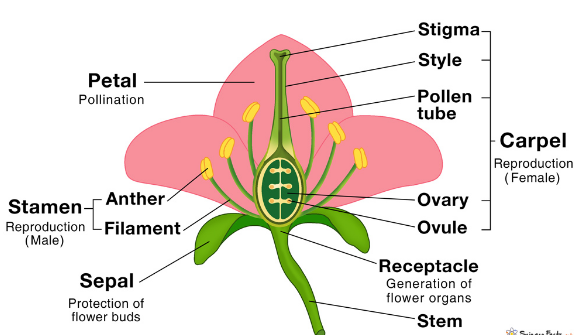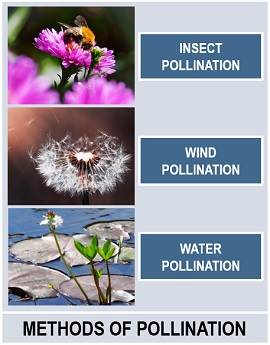Chapter 20: Reproduction in Plants
Asexual Reproduction
Is the ^^production of new individuals^^ that does ^^not involve fertilization^^, i.e. there is no fusion of two reproductive cells called gametes.
Natural vegetation
- Is a form of asexual reproduction.
- Involves the growth of a new plant (daughter) from any part of an old plant.
- ^^Advantages^^
- The process does not need external agencies.
- Since food is usually present in the vegetative structures, buds can develop rapidly into daughter plants.
- The daughter plants resemble the parent plant in every way. Beneficial or desirable qualities in the parent plant are passed on directly to the young plants without any change.
- The process involves only one parent, and no fertilization is required.
- Since plants are already in a suitable habitat, they can colonise the area more rapidly.
- ^^Disadvantages^^
- Lack of any dispersal mechanism may lead to overcrowding, causing the new plants to compete for light and food.
- The new plants are less varied compared to those produced by seeds, thus they may be less adaptable to changes in environmental conditions.
Following are ^^artificial methods of vegetative reproduction^^
- Cutting, layering and marcotting.
- Budding and grafting.
Sexual Reproduction in plants
Involves the ^^fusion of cells called gametes^^. In plants, sexual reproduction takes place in flowers. Two mechanisms involved are pollination and fertilization.
Parts of flower
- Pedicle
- Is a flower stalk.
- Receptacle
- Is the enlarged end of flower stalk.
- Other parts of flower are borne.
- Sepals
- Are modified leaves which enclose and protect the other parts of the flower in the bud stage.
- Petals
- Are modified leaves forming the visible part of the flower.
- Are usually brightly coloured in insect-pollinated flowers.
- Petals have two important functions:
- They are brightly coloured to attract insects for pollination.
- They provide a landing platform for insects.
- Stamens
- Is the collective name for the stamens of a flower which produce pollen grains.
- Is the male part of the flower.
- Consists of a filament bearing an anther.
- The anther is usually made up of two lobes, each containing two pollen sacs (contain pollen grain).
- Pollen grains are produced meiosis so they contain the haploid number chromosomes.
- Each pollen grain gives rise to two haploid male gametes which are the reproductive nuclei of the flower. When anther matures, its two lobes split, setting free the pollen grains.
- The pistil
- Is the female part of the flower.
- Consists of one or more units called carpels.
- A carpel consists of an ovary.

Pollination
Is the transfer of pollen grains from the anther to the stigma.
Method of Pollination
- %%Insect pollination%%
- Insects are attracted to the plant, where pollen sticks to them.
- They then move to another plant and drop the pollen, causing the second plant to be pollinated.
- Pollen that is carried by insects is adapted to be sticky and have hooks which attach to the insect.
- %%Wind pollination%%
- The wind blows pollen off the first plant and carries it to the second plant.
- Pollen carried by the wind does not need to stick to anything, thus its smooth. It is also very light.
Fertilization
- Pollen grains land on a plant stigma.
- If the pollen is of the same species, a pollen tube begins to grow.
- The pollen moves down the pollen tube to the ovule.
- Fertilisation occurs when the nucleus from the pollen cell fuses with a nucleus in an ovule. This produces a %%zygote%%.
- The zygote develops into an embryo plant.
Dispersal of fruits and seeds
%%Why is it important%%
- Avoid overcrowding and competition for food and light with the parent plants.
- Enable plants to colonise new and favourable habitats.
- Reduce the spread of diseases.
%%Dispersal by wind%%
- Small and light so that they can float in the air and be readily be blown.
- Large, flattened wing-like structures or a parachute of fine-hairs.
- Large surface area which increases air resistance.
%%Dispersal by animals%%
- Are brightly coloured, scented and sticky to attract insects.
- Some have hook like structure which hook onto them.
%%Dispersal by water%%
- Adapted to float.

Germination
Is the process during which the ^^food reserves present in a seed are broken down^^ and the ^^embryo starts to grow^^ into a plant.
- %%Conditions%%
- Sufficient supply of water, suitable temperature and adequate oxygen supply.
- %%Types of germination%%
- Epigeal germination where the cotyledons are carried above the ground.
- Hypogeal germination where the cotyledons remain below the surface of the soil.